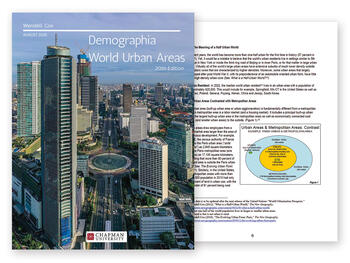
1: Introduction
Demographia World Urban Areas (Built-up Urban Areas or Urban Agglomerations) is the only regularly published inventory of population, corresponding land area and population density for urban areas with more than 500,000 population. Unlike some other regularly produced lists, Demographia World Urban Areas applies a generally consistent definition to built-up urban areas.
2: Defining Urban Areas
Urban areas are urban footprints, or expanses of urbanization on the natural environment. Urban footprint data is reported without regard to political boundaries that are generally associated with metropolitan areas or sub-national jurisdictions. A useful definition was supplied by Alex Blei, of the NYU (New York University) Stern Marron Institute Urban Expansion Project, who described urban areas as contiguous or mostly contiguous built-up areas that “function as an integrated economic unit, linked together by commuting flows, social and economic interactions.”
Combined Urban Areas
This edition of Demographia World Urban Areas introduces a broadened definition that combines adjacent urban areas, where nearby urban areas have become a single urban footprint. This revision has been undertaken especially in response to the spreading of continuous urbanization in China, the ultimate being in the Pearl River Delta (Guangzhou-Shenzhen) and the Yangtze River Delta, stretching from Shanghai to Changzhou, which are now shown as the first and second largest urban areas in the world.
In the United States, single labor markets can be either metropolitan areas (MSAs), or combined statistical areas (CSAs), which are, overlapping metropolitan areas or metropolitan regions, with somewhat weaker commuting interchanges. Where continuous urban footprints exist within a CSA. Demographia World Urban Areas combines them into a single urban area. For example, the New York built-up urban area stretches from New York to other US Census Bureau defined urban areas, such as Bridgeport-Stamford, New Haven, and Trenton and others (Table 1).
In addition, the US Census Bureau has retained some urban areas, despite their now continuous urbanization with other urban areas within the same metropolitan areas. Demographia World Urban Areas combines this into a single built-up urban area. Cleveland and Lorain, Ohio, as well as Orlando and Kissimmee, Florida are examples of this (Table 2).
Read the full report here.
Wendell Cox is principal of Demographia, an international public policy firm located in the St. Louis metropolitan area. He is a Senior Fellow with Unleash Prosperity in Washington and the Frontier Centre for Public Policy in Winnipeg and a member of the Advisory Board of the Center for Demographics and Policy at Chapman University in Orange, California. He has served as a visiting professor at the Conservatoire National des Arts et Metiers in Paris. His principal interests are economics, poverty alleviation, demographics, urban policy and transport. He is author of the annual Demographia International Housing Affordability Survey and author of Demographia World Urban Areas.
Mayor Tom Bradley appointed him to three terms on the Los Angeles County Transportation Commission (1977-1985), which was a predecessor agency to the Los Angeles County Metropolitan Transportation Authority (Metro). Speaker of the House Newt Gingrich appointed him to the Amtrak Reform Council, to complete the unexpired term of New Jersey Governor Christine Todd Whitman (1999-2002). He is author of War on the Dream: How Anti-Sprawl Policy Threatens the Quality of Life and Toward More Prosperous Cities: A Framing Essay on Urban Areas, Transport, Planning and the Dimensions of Sustainability.












